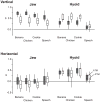Kinematic linkage of the tongue, jaw, and hyoid during eating and speech
- PMID: 20236625
- PMCID: PMC2862248
- DOI: 10.1016/j.archoralbio.2010.02.008
Kinematic linkage of the tongue, jaw, and hyoid during eating and speech
Abstract
Objective: Tongue movement is temporo-spatially coordinated with jaw and hyoid movements during eating and speech. As such, we evaluated: (1) the correlation between the tongue with jaw and hyoid movements during eating and speech and (2) the relative influence of the jaw and hyoid on determining tongue movement.
Design: Lateral projection videofluorography was recorded while 16 healthy subjects ate solid foods or read a standard passage. The position of anterior and posterior tongue markers (ATM and PTM, respectively), the jaw, and the hyoid relative to the upper occlusal plane was quantified with the upper canine as the origin (0,0) point for Cartesian coordinates. For vertical and horizontal dimensions, separate multiple linear regression analyses were performed with ATM or PTM position as a function of jaw and hyoid positions.
Results: Vertically, both ATM and PTM positions were highly correlated with the jaw and hyoid during eating (median r=0.87). The relative influence was higher for the jaw than the hyoid for ATM position (P<0.001), but lower for PTM position (P=0.04). Horizontally, tongue marker positions had moderate correlation with the jaw and hyoid during eating (r=0.47), due more to hyoid position than to jaw position. Overall, correlations were lower during speech than eating.
Conclusion: This study demonstrated distinct kinematic linkages between the movements of the jaw, the hyoid and the anterior and posterior tongue markers, as well as differing impact of the jaw and the hyoid in determining tongue movement during eating and speech.
Figures




Similar articles
-
Hyoid and tongue surface movements in speaking and eating.Arch Oral Biol. 2002 Jan;47(1):11-27. doi: 10.1016/s0003-9969(01)00092-9. Arch Oral Biol. 2002. PMID: 11743928
-
Patterns of tongue and jaw movement in a cinefluorographic study of feeding in the macaque.Arch Oral Biol. 1995 Mar;40(3):229-46. doi: 10.1016/0003-9969(95)98812-d. Arch Oral Biol. 1995. PMID: 7605250
-
Kinematics of lateral tongue-pushing movement in coordination with masticatory jaw movement: An anteroposterior projection videofluorographic study.Physiol Behav. 2023 Oct 15;270:114315. doi: 10.1016/j.physbeh.2023.114315. Epub 2023 Aug 1. Physiol Behav. 2023. PMID: 37536619 Free PMC article.
-
Hyo-mandibular relationships during feeding in the cat.Arch Oral Biol. 1982;27(10):793-801. doi: 10.1016/0003-9969(82)90032-2. Arch Oral Biol. 1982. PMID: 6961891
-
Tongue movements in feeding and speech.Crit Rev Oral Biol Med. 2003;14(6):413-29. doi: 10.1177/154411130301400604. Crit Rev Oral Biol Med. 2003. PMID: 14656897 Review.
Cited by
-
Difference in the Electromyographic Behavior of the Masticatory and Swallowing Muscles During Cued Versus Spontaneous Swallowing.Dysphagia. 2024 Jun;39(3):398-406. doi: 10.1007/s00455-023-10621-x. Epub 2023 Sep 26. Dysphagia. 2024. PMID: 37752277 Free PMC article.
-
Fluoroscopic evaluation of tongue and jaw movements during mastication in healthy humans.Dysphagia. 2013 Sep;28(3):419-27. doi: 10.1007/s00455-013-9453-1. Epub 2013 Feb 28. Dysphagia. 2013. PMID: 23446812
-
Cineradiography of monkey lip-smacking reveals putative precursors of speech dynamics.Curr Biol. 2012 Jul 10;22(13):1176-82. doi: 10.1016/j.cub.2012.04.055. Epub 2012 May 31. Curr Biol. 2012. PMID: 22658603 Free PMC article.
-
Chemoradiation to the submental muscles alters hyoid movement during swallowing in a rat model.J Appl Physiol (1985). 2024 May 1;136(5):1076-1086. doi: 10.1152/japplphysiol.00538.2023. Epub 2024 Mar 14. J Appl Physiol (1985). 2024. PMID: 38482576 Free PMC article.
-
Vertebrate Evolution Conserves Hindbrain Circuits despite Diverse Feeding and Breathing Modes.eNeuro. 2021 Apr 28;8(2):ENEURO.0435-20.2021. doi: 10.1523/ENEURO.0435-20.2021. Print 2021 Mar-Apr. eNeuro. 2021. PMID: 33707205 Free PMC article. Review.
References
-
- Tsuiki S, Ono T, Ishiwata Y, Kuroda T. Functional divergence of human genioglossus motor units with respiratory-related activity. Eur Respir J. 2000;15(5):906–910. - PubMed
-
- Hiiemae KM, Palmer JB. Tongue movements in feeding and speech. Crit Rev Oral Biol Med. 2003;14(6):413–429. - PubMed
-
- Stone M, Lundberg A. Three-dimensional tongue surface shapes of English consonants and vowels. J Acoust Soc Am. 1996;99(6):3728–3737. - PubMed
-
- Ardran GH, Kemp EH. A radiographic study of the movements of the tongue in swallowing. Dent Pract. 1955;5:252–263.
-
- Palmer JB, Hiiemae KM, Liu J. Tongue-jaw linkages in human feeding: a preliminary videofluorographic study. Arch Oral Biol. 1997;42(6):429–441. - PubMed
Publication types
MeSH terms
Grants and funding
LinkOut - more resources
Full Text Sources
Other Literature Sources
Research Materials
Miscellaneous

